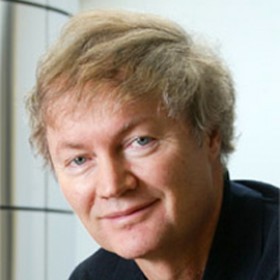
Michael Grätzel
2017 Honorary Doctorate
A solar energy pioneer
Michael Grätzel is a professor at the Ecole Polytechnique Fédérale de Lausanne, where he directs the Laboratory of Photonics and Interfaces of the Institute of Chemical Sciences and Engineering.
He has received a number of prestigious awards including the Global Energy Prize, the Millennium Technology Prize, the Marcel Benoist Prize, the King Faisal International Prize for Science, the Albert Einstein World Award for Science and the Balzan Prize.
He is a member of several learned societies and holds ten honorary doctorates from European and Asian universities. Author of many books and more than 1,200 articles, he is one of the three most cited chemists in the world with more than 180,000 citations.
From photosynthesis to Grätzel cells:
Grätzel cells were invented in the early 1990s based on Michael Grätzel’s idea to reproduce photosynthesis artificially.
During photosynthesis, the photons present in light excite the plant’s natural green pigment (chlorophyll), which gives the electrons enough energy to be released from the pigment. The movement of the electrons causes a chemical reaction that produces energy and allows the plant to grow.
The Grätzel cell, now more commonly known as a dye-sensitized solar cell or DSSC, is composed of two thin plates of conducting glass, one positive and the other negative, like a battery. On the negative plate, a thin layer of titanium dioxide nanoparticles is coated with synthetic dye—a photosensitive pigment. When the cell is exposed to the light, the dye releases electrons. These electrons are then ejected from the dye and captured by the titanium dioxide, flowing from the first plate to the second. It is this movement of electrons that sparks the production of an electric current. See the extremely simplified diagram.
Dye-sensitized solar cells: a photovoltaic revolution
Unlike silicon solar panels, which are opaque, DSSCs can be integrated into transparent panels. See the photo of Mr Grätzel with his panel. They can produce energy even without direct sunlight and with low light levels.
20 years after DSSCs were first designed, a new photosensitive pigment, a hybrid perovskite (see the scientific drawing of the molecule and the artist’s impression), was introduced, triggering a new revolution: the output of DSSCs leaped from 10 percent to 22 percent. In addition, when combined with silicon, perovskite can increase the efficiency of a silicon solar cell by 50 percent, which in practice reduces the cost of solar energy by half.
The drawback of using this hybrid perovskite is that the material deteriorates rapidly through contact with moisture and oxygen, and lead atoms are present in the molecule. Research is underway to address these disadvantages. ENS Paris-Saclay researchers are studying the basic optical properties of hybrid perovskite crystals and attempting to chemically engineer the material, with the aim of finding ways to optimize the molecule.
